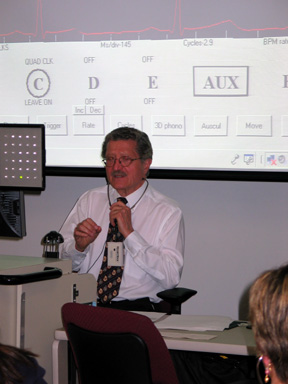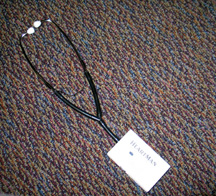 |
Andrew Weis, M.D., teaches heart sounds with a infrared stethophone. |
For years, cardiologist Andrew J. Weis, M.D., has taught students how to listen for the subtle differences in heart sounds and murmurs.
With more than 400 combinations of heart sounds and murmurs, knowing how and what to listen for is key to diagnosing many heart problems.
“I’ve been a product of both the bedside exam, as well as high-tech echocardiography,” Dr. Weis said. “They should complement each other in cardiac diagnosis.”
With today’s technology, students no longer have to rely on actual patients to help them “hear” distinct heartbeats. Instead, an entire classroom of students can simultaneously listen to the heartbeat of a patient with mitral valve prolapse or an atrial septal defect thanks to infrared stethophones.
These stethophones, which feature a 2- by 3-inch infrared receiver box instead of a chestpiece, receive transmitted sound waves from a computer simulator. The wireless technology allows students to experience the heartbeat as though they have placed a stethoscope on a person’s chest.
Dr. Weis most recently used the technology with about 20 practicing health care providers during UNMC’s “Cardiology for the Primary Care Provider” symposium at the Durham Research Center. The participants listened as Dr. Weis “built” artificial heart sounds on the computer simulator and transmitted them to each participant’s stethophone.
“It gives you a good idea of what you should be hearing,” he told the group.
 |
Instead of a chestpiece, the stethophone features a 2- by 3-inch infrared receiver box which receives transmitted sound waves from a computer simulator. |
In addition, every sound is displayed simultaneously as a phonocardiogram, with an ECG, on a large screen, which provides students with a visual representation of what they are hearing, Dr. Weis said. “It’s an outstanding audio-visual teaching modality,” he said.
The artificial heartbeats can be built with respirations — to show how it affects the heart sounds. Individual clicks, snaps or murmurs can be added or removed, which allows students to learn every aspect of a sound complex — one part at a time.